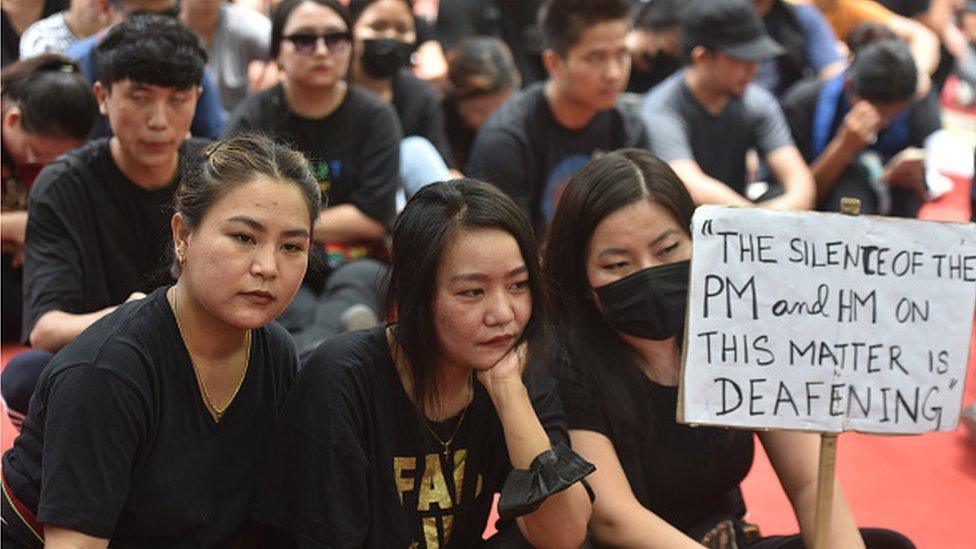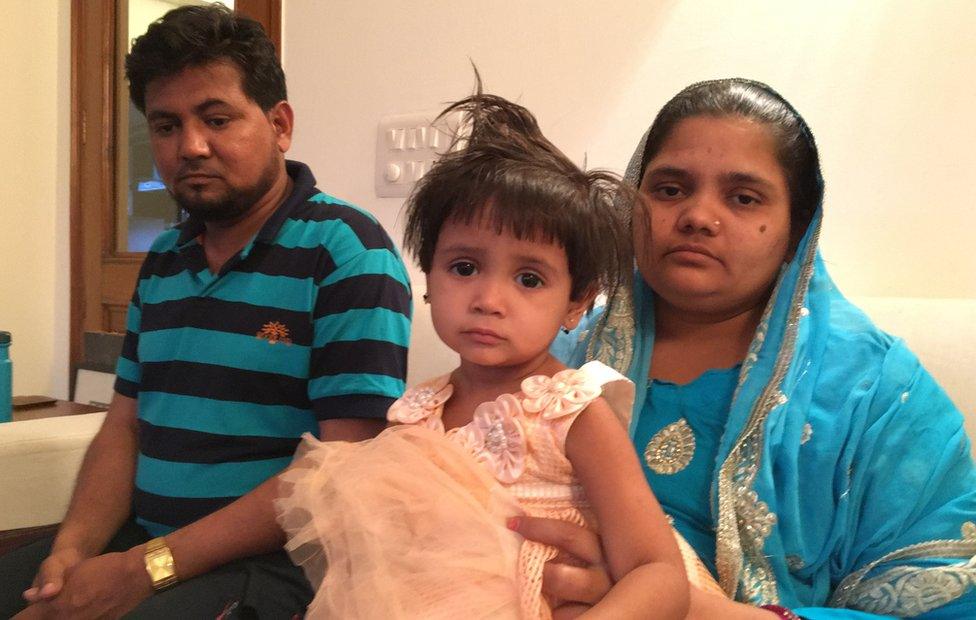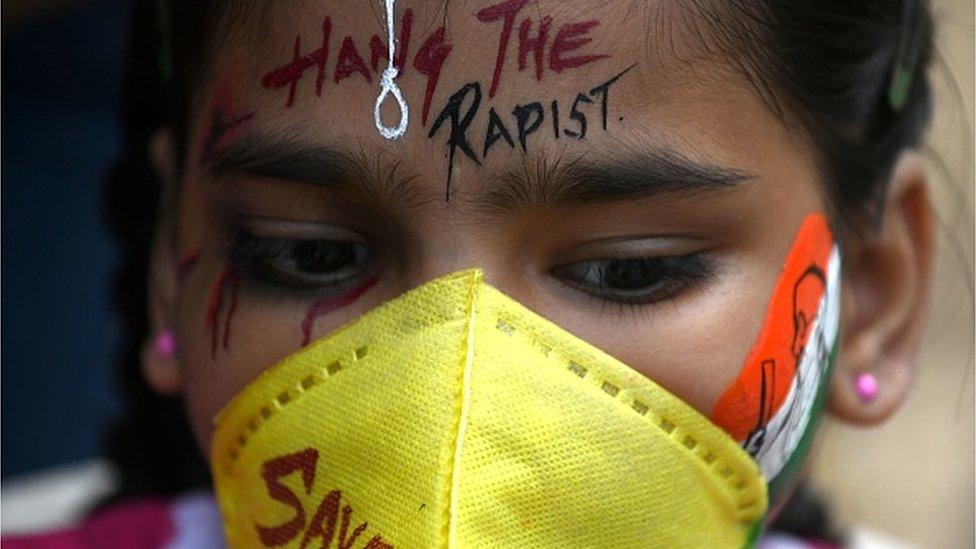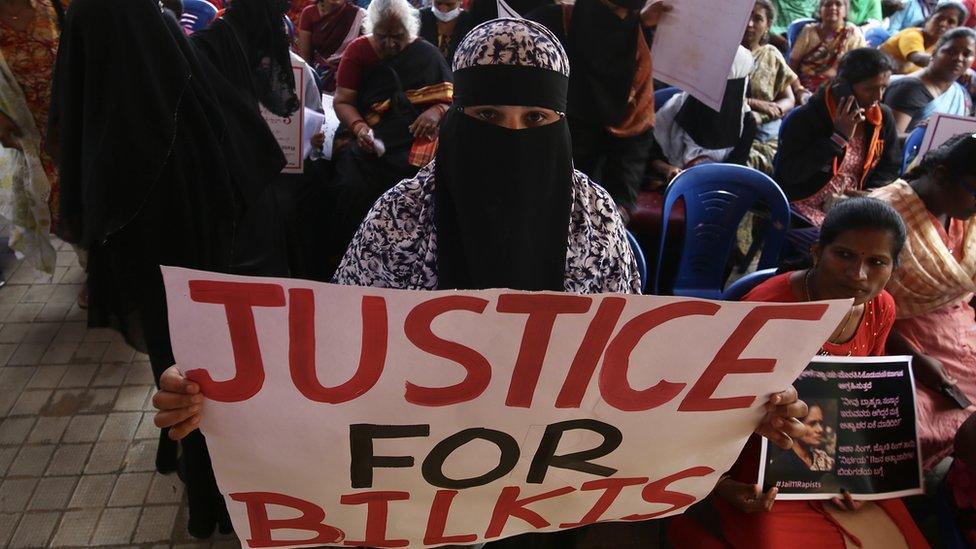Manipur: India video shows how rape is weaponised in conflict
- Published

Indians have often protested against horrifying instances of rape
The emergence of a horrific video that shows two naked women being paraded and molested by a mob in the violence-hit Indian state of Manipur has highlighted who often pays the highest price during conflict.
Warning: This article contains details some readers may find distressing.
The assault on the women took place almost three months ago but became public only on Thursday after the video went viral on Twitter. According to a police complaint, one of the women was gang raped. The complaint added that a third woman was also forced to strip but she is not seen in the video.
The video shows the distraught women being pushed around and groped by their attackers. While the men's faces are visible, only one person has been arrested so far on charges of gang rape.
Manipur, in north-eastern India, has been gripped by ethnic violence between the majority Meitei group and the tribal Kuki minority since May. Reports from the ground detail chilling accounts of shootings, looting and sexual assault.
According to a report in The Print, external, the sexual violence shown in the video took place after fake news about a Meitei woman's rape and murder was circulated just after the violence began. It "unleashed a new, deadly cycle of reprisal violence on Kuki tribal women allegedly by Meitei mobs", says the report.
Rape has long been used as a weapon during conflict.
In most large-scale incidents of violence - the 1947 partition of India, the 1971 Bangladesh independence war, the 1984 anti-Sikh riots, the civil war in Sri Lanka, the 2002 Gujarat riots, to give just a few examples from South Asia - appalling instances of sexual assault and gang rape have been reported, with the scale of the brutality sometimes uncovered only decades later, external.
Survivor accounts show that the crime is often attributed to revenge against the "other" through violating the bodies of women - seen as a site of honour for their communities.
The state's mechanisms to end the conflict - such as the army and other security forces - have also been accused of brutal sexual violence in places such as Indian-administered Kashmir and the north-eastern states.
"The price that women pay for this violence done on their bodies is often hidden and very private. The women's movement has been bringing attention to this for decades, yet it continues," says Anuradha Chenoy, former professor at Jawaharlal Nehru University in Delhi.

A June protest by members of Kuki tribe against the violence in Manipur
What makes matters worse is state apathy.
The assault in Manipur occurred on 4 May. According to the police complaint filed by a relative of one of the women, it took place when two men and three women from the tribal Kuki community were fleeing towards a forest to escape violence in Kangpokpi district.
The complaint alleges that they were rescued by a police team who were then ambushed by a mob who "snatched" the villagers.
According to the complaint, the mob killed the two men and forced the women to remove their clothes.
One of the women, a 21-year-old, was "brutally gang-raped in broad daylight", the complaint says, adding that the other two managed to escape.
Vikram Singh, a former police chief in Uttar Pradesh state, says that the "shameful" incident raises grave questions about the police and administration.
"No administration in a country like India is so helpless that it cannot do anything when women are treated like this," he says, adding that apart from the perpetrators, the police officials in question should also be punished.

Thousands have been displaced due to the violence in Manipur
Yet, the first arrest in the case was only made on Thursday morning, external, hours after the video was shared widely on Twitter and the Supreme Court said it was "deeply disturbed".
Prime Minister Narendra Modi, who has often spoken about empowering women and educating girls, had not publicly commented on the crisis in Manipur despite repeated calls from citizens and opposition leaders. He finally broke his silence a few hours ago, saying his heart was "full of pain and anger" and that the guilty would be punished.
But the question remains - why did it take so long, especially when the faces of the perpetrators were clearly visible in the viral video?
"Ensuring access to justice is the state's responsibility. But in most cases, the state and administration are totally missing in the fight for justice," says Vrinda Grover, an advocate who has represented several victims of sexual violence.
She adds that if it takes the Supreme Court's intervention for even one arrest to be "miraculously" made, it does not give any hope to victims of violence.
Khushbu Sundar, a member of Mr Modi's party - the Bharatiya Janata Party (BJP), which also governs Manipur - said the video was "horrific" and "unacceptable".
"This is a complete failure of law and order," she said, adding, however, that this was "not the time for accusations" and that all political parties needed to keep aside their differences and "stand together against the violence in Manipur".
Lawyer Warisha Farasat, who researched the 1989 Bhagalpur riots, external in Bihar state in which more than 1,000 people were killed, said that two commissions set up by the government to investigate the violence did not mention sexual assault or rape at all in their reports.
"I did my research 21 years after the incident and people were still reluctant to talk about it. The only cases where families spoke about sexual violence were those where the victim had died in the assault, perhaps because there was no rape-related social stigma involved," she says.
In India, sexual violence often goes unreported as traumatised victims fear being cast out by their families and ostracised by society.
Ms Farasat says that victims of sexual violence in conflict zones are also facing overlapping traumas - from loss of livelihood to deaths of family members - which can make them minimise their experiences.
She adds, however, that the reluctance does not always stem from shame.
"The problem is, when women come out to speak, they don't get justice. That's what needs to change," Ms Farasat adds.
While there are sporadic instances of legal justice, it often takes years and a lot of strength from the victims, who are already economically marginalised and may have been forced to move away from their homes due to fear and shame.
Earlier this year, two Hindu men were sentenced to 20 years in jail, external for gang-raping a Muslim woman in 2013 during communal riots in Uttar Pradesh. The verdict was a landmark one but Ms Grover, who represented the complainant, points out that seven women had initially approached the court alleging sexual violence.
"Finally, only one woman stood and testified against her attackers," she says.

Bilkis Bano was gang-raped during the 2002 anti-Muslim violence in Gujarat
Another example, Ms Farasat says, is Bilkis Bano, who was gang-raped and saw 14 members of her family being murdered by a Hindu mob during the 2002 anti-Muslim riots in Gujarat state. But the 11 convicts in the case were granted an early release from jail last year by the state's BJP government - when the men walked free on India's independence day, relatives celebrated by giving them sweets and touching their feet. Reports said the men were also garlanded by activists of a hardline Hindu organisation.
"In Bilkis's case, the wheels of justice did turn in her favour but we've come full circle and now the convicts are out again. Yet, even for that limited justice, Bilkis is an exception because she was one of the very few victims who was able to fight her case. Hers is a landmark case because she was the exception to the rule," she says.
The state often offers compensation to victims but what they need is reparations, Ms Grover says.
"That includes rehabilitation, the guarantee of non-recurrence of the attack and social and economic restitution," she says.
What needs to end, adds Ms Farasat, is the culture of impunity that gets strengthened with each successive incident.
"It's not just mobs, but also authorities such as police officers and politicians - everyone needs to be held accountable."
BBC News India is now on YouTube. Click here, external to subscribe and watch our documentaries, explainers and features.

Read more India stories from the BBC:

Related topics
- Published13 September 2022

- Published27 August 2022
